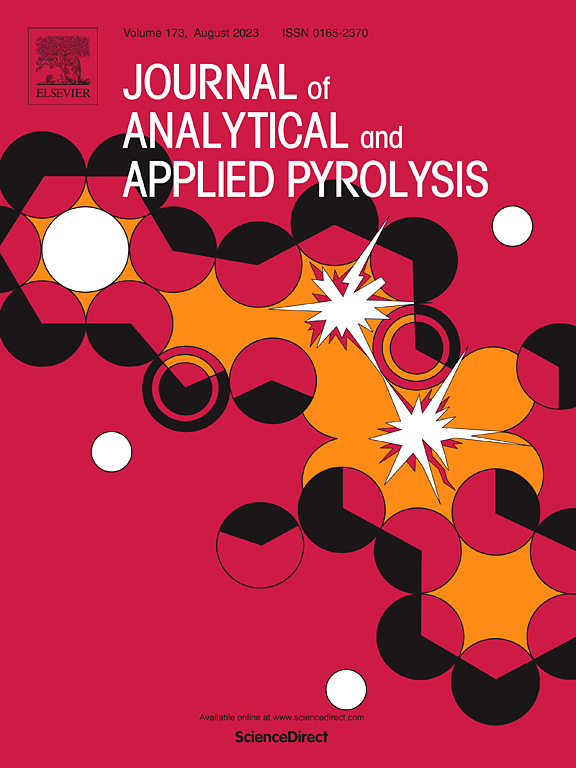基于几丁质的新型富能多糖的热解机理及特性研究
IF 6.2
2区 化学
Q1 CHEMISTRY, ANALYTICAL
引用次数: 0
摘要
甲壳素是一种广泛使用的生物聚合物,在高能材料中仍未得到充分的开发。为了解决这一空白,本研究重点研究了一种由甲壳素硝化衍生的新型高能多糖的合成及其热解机理。利用各种分析技术对硝基几丁质及其前体进行了广泛的表征,证实了几丁质通过亲电硝化成功实现了功能化。采用傅里叶变换红外光谱(FTIR)、x射线衍射(XRD)、扫描电镜(SEM)、元素分析和电子密度计对NCT的结构和理化性质进行了表征。实验结果表明,合成的NCT具有良好的物理化学特性。此外,利用热重分析(TGA)和差示扫描量热法(DSC)研究了硝化甲壳素的热行为。结果表明,NCT在135 ~ 185℃和192 ~ 244℃的温度范围内经历了两次连续的放热分解过程。利用热重-红外联用分析对其热分解机理进行了分析。进化出的气体表明一种复杂的混合物,主要由二氧化碳(CO₂)、氮氧化物(NO₂)、水蒸气(H₂O)、甲烷(CH₄)、氰化氢(HCN)、甲醛(CH₂O)、乙酰胺(CH₃CONH₂)和乙酸(CH₃COOH)组成。这些发现突出了新合成的NCT作为炸药和固体火箭推进剂中有前途的成分的潜力。本文章由计算机程序翻译,如有差异,请以英文原文为准。
Pyrolysis mechanism and characteristics of a novel promising energy rich polysaccharide based on chitin
Chitin, a widely available biopolymer, remains underexplored in energetic materials. To address this gap, this study focuses on the synthesis and pyrolysis mechanism of a novel energetic polysaccharide derived from nitration of chitin. Nitrochitin (NCT) and its precursor were extensively characterized using various analytical techniques, confirming the successful functionalization of chitin via electrophilic nitration. The structural and physicochemical properties of NCT were examined using Fourier transform infrared spectroscopy (FTIR), X-ray diffraction (XRD), scanning electron microscopy (SEM), elemental analysis, and an electronic densimeter. Experimental findings demonstrated that the synthesized NCT exhibits promising physicochemical characteristics. Additionally, the thermal behavior of nitrated chitin was investigated using thermogravimetric analysis (TGA) and differential scanning calorimetry (DSC). The results revealed that NCT undergoes two consecutive exothermic decomposition processes within the temperature ranges of 135–185 °C and 192–244 °C. Furthermore, the thermal decomposition mechanism was elucidated using hyphenated TGA-FTIR analysis. The evolved gases indicated a complex mixture primarily composed of carbon dioxide (CO₂), nitrogen oxides (NO₂), water vapor (H₂O), methane (CH₄), hydrogen cyanide (HCN), formaldehyde (CH₂O), acetamide (CH₃CONH₂), and acetic acid (CH₃COOH). These findings highlight the potential of the newly synthesized NCT as a promising component for use in explosives and solid rocket propellants.
求助全文
通过发布文献求助,成功后即可免费获取论文全文。
去求助
来源期刊
CiteScore
9.10
自引率
11.70%
发文量
340
审稿时长
44 days
期刊介绍:
The Journal of Analytical and Applied Pyrolysis (JAAP) is devoted to the publication of papers dealing with innovative applications of pyrolysis processes, the characterization of products related to pyrolysis reactions, and investigations of reaction mechanism. To be considered by JAAP, a manuscript should present significant progress in these topics. The novelty must be satisfactorily argued in the cover letter. A manuscript with a cover letter to the editor not addressing the novelty is likely to be rejected without review.

 求助内容:
求助内容: 应助结果提醒方式:
应助结果提醒方式:


